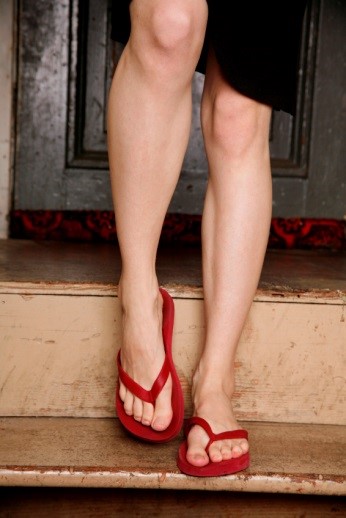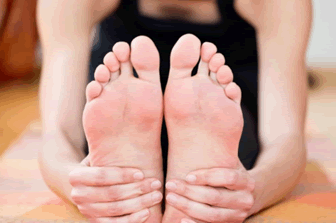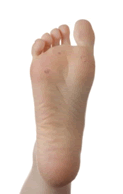Items filtered by date: May 2015
Reasons to Avoid Flip Flops This Summer
 As the weather begins to transition into a warmer atmosphere, many individuals will want to slip into more comfortable flip-flops; however, Cosmopolitan has come up with a few reasons why you should avoid the shoe type this season. Flip-Flops expose the feet to bacteria and other infections that can cause irritation to the skin as well as exposing the feet to athlete’s foot and HPV the cause of plantar warts. Studies have also shown that flip flops cause you to slow down and make you clumsier because of the shorter stride you would have to take while wearing the shoe. The thin strap that keeps the shoe on the foot is also a major cause of blisters and the thin foam in between the foot and the ground often cause heel pain, poor posture, shooting pains, and other foot problems.
As the weather begins to transition into a warmer atmosphere, many individuals will want to slip into more comfortable flip-flops; however, Cosmopolitan has come up with a few reasons why you should avoid the shoe type this season. Flip-Flops expose the feet to bacteria and other infections that can cause irritation to the skin as well as exposing the feet to athlete’s foot and HPV the cause of plantar warts. Studies have also shown that flip flops cause you to slow down and make you clumsier because of the shorter stride you would have to take while wearing the shoe. The thin strap that keeps the shoe on the foot is also a major cause of blisters and the thin foam in between the foot and the ground often cause heel pain, poor posture, shooting pains, and other foot problems.
Flip-flops can cause a lot of damage to the feet and rest of the body. If you have any concerns about your foot and ankle needs contact Dr. Michael E. Newman and Dr. Denise Kohler of Pennsylvania. Our doctor will treat your foot and ankle needs.
Flip-Flops and Feet
Flip-flops are not only very popular, but very convenient, especially in the warmer weather. They allow your feet to breathe and let you move your toes freely. They also go with most attire and can be worn with many different clothing styles. Unfortunately, these type of shoes also have a disadvantage, as they can cause harm to your feet in more ways than you think. These symptoms include:
- Ball and arch problems in the foot
- Changes to the body’s natural gait
- Blisters
- Ankle Sprains
- Higher risk of infection
- Higher risk of scrapes and cuts to the feet
- Issues in the lower back, legs and ankles
To avoid these symptoms (and minimize your risks), select a pair of flip-flops made of high quality materials that can offer protection. Purchase flip-flops from a reliable manufacturer and be sure to replace them every three to four months. Be sure the soles are firm and not ‘floppy’, or that they don’t bend or wiggle a lot when lifted from the floor.
You can still wear your favorite pair of flip-flops if you so choose, just don’t wear them for extended periods of time, and especially not every day. However, it would be far wiser to purchase a more expensive pair of flip-flops or to refrain from wearing the shoe at all for the sake of your foot health. While these shoes are comfortable, the risks included with wearing them are not.
If you have any questions please feel free to contact our offices located in Plymouth Meeting and Ambler, PA. We offer the newest diagnostic tools and technology to treat your foot and ankle needs.
Doctor Discusses Plantar Fasciitis Treatment
 In an interview with NPR, Dr. Navan Duggal discusses plantar fasciitis as well as treatment for the condition. Two million people in the United States, with men and runners being the most prominent, suffer from plantar fasciitis every year. The condition occurs when the plantar fascia, the thick band running from the toes to the heel of the feet, receives excessive strain and trauma causing pain near the heel. “Usually the problem is that patients have this pain and they haven’t really addressed it,” Duggal States. Sometimes the condition starts as mild pain in the heel or through a tight Achilles tendon or calf muscle. Duggal also states that stretching the feet as well as wearing orthotic inserts helps relieve the pain of plantar fasciitis.
In an interview with NPR, Dr. Navan Duggal discusses plantar fasciitis as well as treatment for the condition. Two million people in the United States, with men and runners being the most prominent, suffer from plantar fasciitis every year. The condition occurs when the plantar fascia, the thick band running from the toes to the heel of the feet, receives excessive strain and trauma causing pain near the heel. “Usually the problem is that patients have this pain and they haven’t really addressed it,” Duggal States. Sometimes the condition starts as mild pain in the heel or through a tight Achilles tendon or calf muscle. Duggal also states that stretching the feet as well as wearing orthotic inserts helps relieve the pain of plantar fasciitis.
Plantar fasciitis can be very painful and inconvenient. If you are experiencing heel pain or symptoms of plantar fasciitis, visit Dr. Michael E. Newman of Pennsylvania. Our doctor can treat your heel pain as well as any other foot or ankle condition.
What is Plantar Fasciitis?
Plantar fasciitis is the inflammation of a the thick band of tissue that runs along the bottom of your foot, known as the plantar fascia, and causes mild to severe heel pain.
What Causes Plantar Fasciitis?
- Excessive running
- Non-supportive shoes
- Overpronation
- Repeated stretching and tearing of the plantar fascia
How Can It Be Treated?
- Conservative measures – anti-inflammatories, ice packs, stretching exercises, physical therapy, orthotic devices
- Shockwave therapy – sound waves are sent to the affected area to facilitate healing and are usually used for chronic cases of plantar fasciitis
- Surgery – usually only used as a last resort when all else fails. The plantar fascia can be surgically detached from the heel
While very treatable, plantar fasciitis is definitely not something that should be ignored. Especially in severe cases, speaking to your doctor right away is highly recommended to avoid complications and severe heel pain. Your podiatrist can work with you to provide the appropriate treatment options tailored to your condition.
If you have any questions, please contact our offices in Plymouth Meeting and Ambler, PA. We offer the newest diagnostic and treatment technologies for all your foot and ankle injuries.
Plantar Warts Will Not Necessarily Lead to Long Term Health Problems
 Dr. Faith of The Columbus Dispatch recently discussed the long term effects of plantar warts. Although plantar warts are caused by Human Papillomavirus (HPV) and certain strains of the virus have been associated with cancer, this does not mean your plantar wart will result in future complications. Often time most warts are benign and once they are treated effectively and gone, they will come back to cause additional problems. On certain occasions when a wart is not effectively treated, the virus might reappear on the skin after months or years of remaining unnoticed.
Dr. Faith of The Columbus Dispatch recently discussed the long term effects of plantar warts. Although plantar warts are caused by Human Papillomavirus (HPV) and certain strains of the virus have been associated with cancer, this does not mean your plantar wart will result in future complications. Often time most warts are benign and once they are treated effectively and gone, they will come back to cause additional problems. On certain occasions when a wart is not effectively treated, the virus might reappear on the skin after months or years of remaining unnoticed.
Plantar warts can be very unsightly and uncomfortable. If you have any concerns with plantar warts on your feet contact Dr. Michael E. Newman of Pennsylvania. Our doctor will treat your foot and ankle needs.
About Plantar Warts
Plantar warts are the result of HPV, or human papillomavirus, getting into open wounds on the feet. They are mostly found on the heels or balls of the feet.
While plantar warts are generally harmless, those experiencing excessive pain or those suffering from diabetes or a compromised immune system require immediate medical care. Plantar warts are easily diagnosed, usually through scraping off a bit of rough skin or by getting a biopsy.
Symptoms
• Legions on the bottom of your feet, usually rough and grainy
• Hard or thick callused spots
• Wart seeds, which are small clotted blood vessels that look like little black spots
• Pain, discomfort, or tenderness of your feet when walking or standing
Treatment
• Freezing
• Electric tool removal
• Laser Treatment
• Topical Creams (prescription only)
• Over-the-counter medications
To help prevent developing plantar warts, avoid walking barefoot over abrasive surfaces that can cause cuts or wounds for HPV to get into. Avoiding direct contact with other warts, as well as not picking or rubbing existing warts, will help prevent the further spread of plantar warts. However, if you think you have developed plantar warts, speak to your podiatrist. He or she can diagnose the warts on your feet and recommend the appropriate treatment options.
If you have any questions please feel free to contact our offices located in Plymouth Meeting and Ambler, PA. We offer the newest diagnostic tools and technology to treat your foot and ankle needs.
Health Benefits of Swimming
 When the warmer months begin to come through, pools open up bringing light to the health benefits of swimming. Since swimming involves nearly every muscle in the body, it is a great way to improve blood circulation in the feet and in many other parts of the body. The activity is also highly aerobic and can burn many calories without having to put the same amount of pressure on the ankles and feet as activities such as running or other forms of cardio. Swimming also helps stretch the ligaments in the body that may become less flexible with injury or age.
When the warmer months begin to come through, pools open up bringing light to the health benefits of swimming. Since swimming involves nearly every muscle in the body, it is a great way to improve blood circulation in the feet and in many other parts of the body. The activity is also highly aerobic and can burn many calories without having to put the same amount of pressure on the ankles and feet as activities such as running or other forms of cardio. Swimming also helps stretch the ligaments in the body that may become less flexible with injury or age.
Swimming is a great way to exercise the feet. If you have any questions regarding the benefits of swimming on the feet, consider contacting Dr. Michael E. Newman of Pennsylvania. Our doctor will explain the unique health advantages this activity has and recommend some simple exercises.
Benefits of Swimming and Foot care
Our feet receive the most stress on a daily basis. Walking, running, and long standing contribute to pain and stress on the feet. Swimming helps promote circulation and keep the body feeling great and healthy.
Benefits of swimming:
Improve blood circulation
- Swimming is a good, safe way to get in extra physical activity and improve circulation, without causing further trauma to the feet
Relieve aches or pains
- It takes all the pressure off of them, allowing the feet to relax and recover, and improves blood flow to them.
Circulation overall for diabetics
- Swimming contributes to blood flow, and increase oxygen levels within the body.
Reduce foot inflammation
- Swimming in warm water can increase blood flow and make it easier to move and stretch the afflicted foot. The feet are also exposed in water, giving them much needed air.
Swimming the helpful alternative:
Many people like the elderly and diabetics suffer from weakened muscles and joints. A water sport like swimming will support the body, thus allowing him or her to move freely. Blood flow circulation is a main trigger to tired inflamed feet.
If you have any questions, please feel free to contact our offices located in Plymouth Meeting and Ambler, PA. We offer the latest in diagnostic and treatment technologies to meet all your needs.
